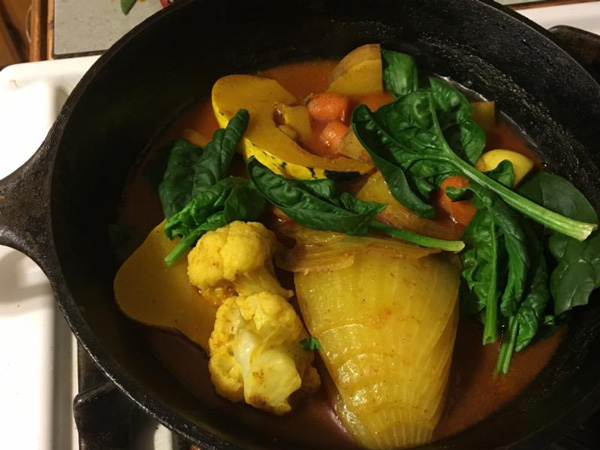The Greens of Winter


Ten years ago, winter was still a time of deprivation for those who aspired to follow a local, seasonal diet. With the passing of each summer, the farmers markets would shutter, and the range of produce would dwindle from plethora of plant parts to a precious few, mostly roots with dirt ground into their skins. While summertime farmers markets have been spreading nationally like a fibrous green plague, the locavore’s wintertime diet was looking rather bleak until winter markets began appearing in their wakes.
Winter markets are a distilled version of summer version, with all of the adventure and goofiness of the summer market, all the gossip, recipes and friendship. It was about this time last year that “Fungus” Charlie began bringing fresh white truffles to market, freshly dug from the Oregon hills. He boasted that his truffles were so powerful you could enclose one with a dozen eggs in a plastic bag. The truffle flavor would pass through the shell and egg white, Charlie claimed, and accumulate in the yolks. It worked, and soon all the egg vendors at market were selling truffled eggs, for a premium. This type of intrigue is what we call entertainment at the winter farmers market.
Winter markets, and the evolving basket of agricultural innovations that help supply them, are game-changers in the world of local, seasonal eating. Growers have an opportunity to produce income during what has historically been a dead period for the farming business. And for a farm on the edge of making it, every bit of extra cash makes a difference. The pace of a winter market is not as frenetic as it can be in its summer counterpart. The crowds are smaller. There are few pressing engagements to which anyone has to rush off. With less going on, there is more time to talk. Relationships built indoors around steaming cups can pay future dividends for growers and consumers alike.
Nationwide, the number of markets has quintupled since 1994, according to USDA, to 8,669 markets in late 2016. While this growth has begun to slow in recent years, the number of winter markets has exploded. If you do a Google News search of winter markets, the results are littered with signs of growth, including the announcements of new markets left and right, and young markets returning for their 2nd or 3rd years. The winter market in Portland, Maine, has grown so fast that, since being launched in 2011, it is already in its third home.
“We are seeing a lot of winter markets extending because farmers are putting up greenhouses and hoop houses,” Peter Wood of USDA’s agricultural marketing service tells me. “Now that farmers can grow food later into the season, they need places to sell it.”
Maine farmer Eliot Coleman, author of the seminal New Organic Grower, has pioneered many of the season-extending techniques that are allowing winter markets to boom, including the use of multiple row cloth inside hoop houses to extend the seasons. Three of his books deal specifically with the winter green lifestyle, including Four-Season Harvest, The Winter Harvest Handbook, and most recently, the Four Season Farm Gardener’s Cookbook, co-authored with his partner Barbara Damrosch. When I reached Coleman, last week, he’d just sown seeds of kale, Asian greens, and Asian broccoli in his greenhouse. He waxed about how pleasant it is to be inside a warm, sunny place amongst growing plants, and told me I could build one myself for $5 a square foot. “A hoop house is the cheapest form of indoor structure you can build,” he said.
At their winter market the day before, their stand was so loaded with spinach, arugula, broccoli, Brussels sprouts, baby leaf salads, kale and radicchio that they didn’t even bother with typical winter crops like potatoes or onions.
“Fresh greens are what really have made winter markets happen,” Coleman says. “If it was just carrots and beets and celeriac it wouldn’t draw in the crowds.”
I’ve always wanted a greenhouse, and I’ve always wanted a root cellar. But thanks to my hometown winter market, maybe I no longer need one. There is no need to stockpile squash and carrots, because I have weekly access to the roots cellars of several area farmers, via the market. I also have access to a sheep cheese creamery, multiple flocks of layer hens, several pastry chefs, a fermentologist, and even a pack of gift-making elves-the makers of soap, gourd-craft, wooden carvings and other local art. Our winter market even takes place in a bar, which pretty much seals the deal.
Perhaps nothing epitomizes a distillation of the summer market like little bags of dark green kale sprouts for sale, dense with kale flavor. But the dried morels and porcini mushrooms for sale were a close second. And then there is the potato lady of Mountain Spring Farms in Paradise, Montana.
Like a species of fish adapted to life at the bottom of the ocean, with no need for the surface, Mountain Spring Farms doesn’t even bother selling at the summer market. But in winter, they show up with their spectacular potatoes, and the people show up with their money.
Last week, I bought some of their huckleberry potatoes, with their thick purple skins and buttery yellow flesh. At another stand, I bought six golf ball-sized celery root balls for a dollar each. I also got greenhouse parsley, onions, a huge bag of spinach heads, a loaf of bread, some collard greens, a parsnip, a bunch of carrots, a sweet dumpling squash, and a potent and delicious fermented beet beverage called kvass.
At home, I perused the winter pages of Coleman and Damrosch’s Four Season Farm Gardener’s Cookbook. Their recipes are simple, and easy to modify with whatever winter produce is available.
With my huckleberry potatoes and celery root, aka celeriac-which Coleman points out is not a root but an enlarged lower stem of a certain type of celery-I followed the directions for a potato celery root mash. It was sensational, with an artichoke-ish aftertaste and a lusty decadence that made me thirst for red wine.
Then, following a red curry recipe, I put my squash, onions, garlic, carrots, celeriac, and squash to use, plus a bit of deer meat. I finished the dish with wilted spinach and garnished with kale sprouts. I’ve never seen my kids eat so much green, which, like the color itself, is all the more striking to see at the end of November.
Potato and Celery Root Mash
(From Four Season Farm Gardener’s Cookbook. Used with permission; paraphrased for brevity.)
Bring water to a boil in a pot or saucepan. Cut 1 pound of potatoes in to inch cubes. Trim, peel, and scrub ½ pound of celeriac and cut into inch cubes. Add all cubes to the pot and simmer until soft. Drain and set aside. In an empty pan, melt 2 tablespoons butter and add a medium-sized onion, minced. Stir often until onion is translucent, and add two bay leaves and a teaspoon of thyme. Then, a cup or so of heavy cream. Simmer for about five minutes, remove the bay leaves, add the potato and celery root chunks, and mash it all together. Season with salt and black pepper, and garnish with chopped parsley.
Coleman and Damrosch serve it with browned butter. I cooked parsley and garlic in butter with a squeeze of lime, for a sauce, and it was excellent.
